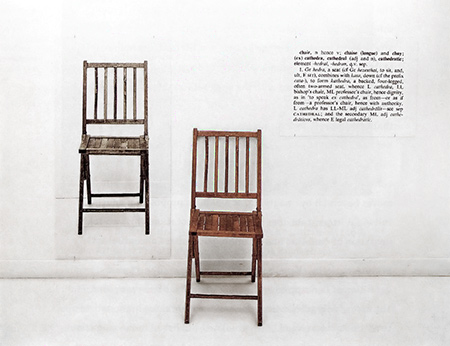What’s so great about art?

Joseph Kosuth, “One and Three Chairs” (1965)
[Update 4 October 2014: See the bottom of this post for a bit more.]
This is a response to this recent post, which is itself a response to Janey Smith’s “Fuck List,” originally published at this site. It’s also a response to the numerous comments on the original post. Because it seemed to me that, as of this writing, a lot of the debate over Smith’s post, and the book that’s apparently resulted from it (which I’ve not seen), has taken the form, “Is what Smith did art?” Mind you, I doubt this post will settle that debate, but I hope it provides
- some historical context I think relevant to Smith’s post;
- plus an argument why, at the end of the day, I don’t think that it really matters whether Smith was making art.
I guess I should also note, in passing, that my name was the first name on Smith’s “Fuck List” (thanks to the magic of alphabetization). Since I find myself (along with numerous others) the object of some obscure desire, perhaps I can offer a few thoughts on the subject.
Experimental fiction as genre and as principle
A few years ago at Big Other I wrote a post entitled “Experimental Art as Genre and as Principle.” That distinction has been on my mind as of late, so I thought I’d revisit the argument. My basic argument then and now was that I see two different ways in which experimental art is commonly defined.
By principle I mean that the artist is committed to making art that’s different from what other artists are making—so much so that others often don’t even believe that it is art. As contemporary examples I’m fond of citing Tao Lin and Kenneth Goldsmith because I still hear people complaining that those two men aren’t real artists—that they’re somehow pulling a fast one on all their fans. (Someday I’ll explore this idea. How exactly does one perform a con via art? Perhaps it really is possible. Until then, I’ll propose that one indication of experimental art is that others disregard it as a hoax.) Tao visited my school one month ago, and after his presentation some folks there expressed concern, their brows deeply furrowed, that he was a Legitimate Artist—so this does still happen. (For evidence of Goldsmith’s supposed fakery, keep reading.)
Eventually, I bet, the doubts regarding Lin and Goldsmith will fall by the wayside. Things change. And it’s precisely because things change that the principle of experimentation must keep moving. The avant-garde, if there is one, must stay avant.
That’s only one way of looking at it, however. Experimental art becomes genre when particular experimental techniques become canonical and widely disseminated and practiced. The experimental filmmaker Stan Brakhage, during the 1960s, affixed blades of grass and moth wings to film emulsion, and scratched the emulsion, and painted on it, then printed and projected the results. Here is one example and here is another example. And here is a third; his films are beautiful and I love them. (The image atop left hails from Mothlight.) Today, countless film students also love Brakhage’s work, and use the methods he popularized to make projects that they send off to experimental film festivals. (Or at least they did this during the 90s, when I attended such festivals; I may be out of touch.)
Those films, I’d argue, while potentially beautiful and interesting, are not necessarily experimental films. As far as the principle of experimentation goes, those students had might as well be imitating Hitchcock.

